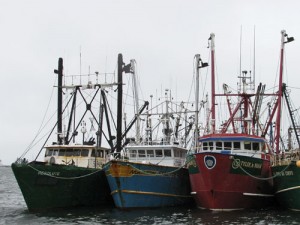
This section has definitions of terms, acronyms, and other information related to commercial fishing.
Commercial Fishing Gear
Fixed gear – stationary equipment such as fish traps, lobster pots, anchored longlines, etc.
Longline – a main line which is usually anchored at one or both ends and contains multiple branching leaders with baited hooks.
Fish Trap – a stationary trap or pot which is equiped with a trap door allowing fish to enter but not escape.
Mobile Gear – trawls, beam trawls, and dredges that are attached to a vessel at all times and which maneuver with the vessel.
Trawl – gear consisting of a net that is towed, including but not limited to beam trawls, pair trawls, Danish seines, and Scottish seines.
Beam Trawl – gear consisting of a twine bag attached to a beam attached to a towing wire. The gear is designed so that the beam does not contact the bottom. Beam trawls are designed to slide along the bottom rather than dredge the bottom.
Dredge – also called dredge gear. Dredges are constructed with a mouth frame attached to a holding bag. The bag is constructed of metal rings, Large dredges are is used in the harvest of Atlantic sea scallops and surf clams.
Channel Net – anchored nets that are very similar to shrimp trawls. They are held open at the mouth by long wooden poles. The nets are placed perpendicular to the tidal current and shrimp are captured as the tidal current carries them seaward. By-catch of fish is usually relatively low.
Fisheries – Regulations – Statistical
Alaska Fisheries Information Network (AKFIN) – a regional program that consolidates and supports the collection, processing, analysis, and reporting of fisheries statistics for North Pacific and Alaskan fisheries.
Atlantic Coastal Cooperative Statistics Program (ACCSP) – a cooperative state-federal program of U.S. states and the District of Columbia that designs, implements, and conducts marine fisheries data collection programs to form a single data management system to meet the needs of fishery managers, scientists, and fishermen.
BAYS – collective acronym for Atlantic bigeye, northern albacore, yellowfin, and skipjack tunas
Code of Federal Regulations (USA) – the codification of the general and permanent rules published in the Federal Register by the executive departments and agencies of the Federal Government of the United States of America.
eVTR – Electronic Vessel Trip Report
Fisheries Information System (FIS) – Program that facilitates access to comprehensive, high-quality, and timely information on U.S. fisheries.
GIFA – Governing International Fishery Agreement
Highly migratory species (HMS) – pelagic fish that travel long distances and often cross domestic and international boundaries.
IFMP – Integrated Fisheries Management Plan (Canada)
Individual Fishing Quotas (IFQ) – a type of limited access privilege program (LAPP), which provides individual fishermen or corporations the exclusive privilege to harvest a certain percentage of the total allowable catch (TAC) of a fishery. IFQ programs allow individual licenses or “shares” to be bought and sold in the marketplace.
IUU Fishing – illegal, unregulated, and unreported fishing
Landings – bringing a harvest of seafood to port. The act of landing occurs when the a vessel secures lines to a dock.
Magnuson-Stevens Fishery Conservation and Management Act (USA) – the Magnuson Fishery Conservation and Management Act of 1976 established a U.S. exclusive economic zone (EEZ) between 3 and 200 miles offshore, and created eight regional fishery councils to manage the living marine resources within that area. The bill was amended on October 11, 1996 and re-named the Magnuson-Stevens Fishery Conservation and Management Act.
Offloading – the process of removing a catch from a vessel.
Sector – a group of persons holding limited access vessel permits who have voluntarily entered into a contract and agree to certain fishery restrictions for a specified period of time, and which has been granted a TAC(s) [total allowable catch] in order to achieve objectives consistent with applicable Fishery Management Plan goals and objectives. (New England Fishery Management Council, Sector Policy, 2008)
Vessel Monitoring Systems (VMS) – technology which allows organizations to monitor geographic position, time, course, and speed of commercial fishing vessels.
VTR – Vessel Trip Report
Western Pacific Fisheries Information Network (WPacFIN) – a cooperative fisheries data warehouse that provides database management, programming, and technical services to support a network of U.S. Pacific island partners.
General Seafood Terms
Sustainable Seafood – the practice of harvesting seafood in such a way that populations are kept at a level high enough to reproduce to enough to sustain optimum levels of abundance.
Seafood – Related Diseases and Health Issues
Vibrio (Vibrio parahaemolyticus) – a bacterium that occurs naturally in coastal waters. It thrives under warm temperatures and is typically linked to oysters and other seafood harvested and consumed raw during the summer months. Consuming seafood tainted with Vibro can cause illness, especially in people with compromised immune systems.
Scombrotoxin (histamine) Poisoning – scombrotoxin poisoning, also called histamine or scombroid poisoning, occurs when people eat fish that have been carelessly handled and permitted to build up biogenic amines such as histamine, cadaverine, and putrescine as a consequence of bacterial spoilage.
Mycobacteriosis – a bacterial disease in which fish may be disfigured as a result of skin ulcers and internal lesions. The fish may also be skinny or in extremely poor condition due to the chronic nature of this wasting disease. Some of the mycobacteria that commonly infect fishes can cause infections in people and therefore are a human health concern.
Special Terms
Customary Exchange – A non-market exchange of goods, services, and social support. It differs from monetary exchange and even trade and barter in that there is not a calculated equivalency or an expectation of immediate return.
Related Information